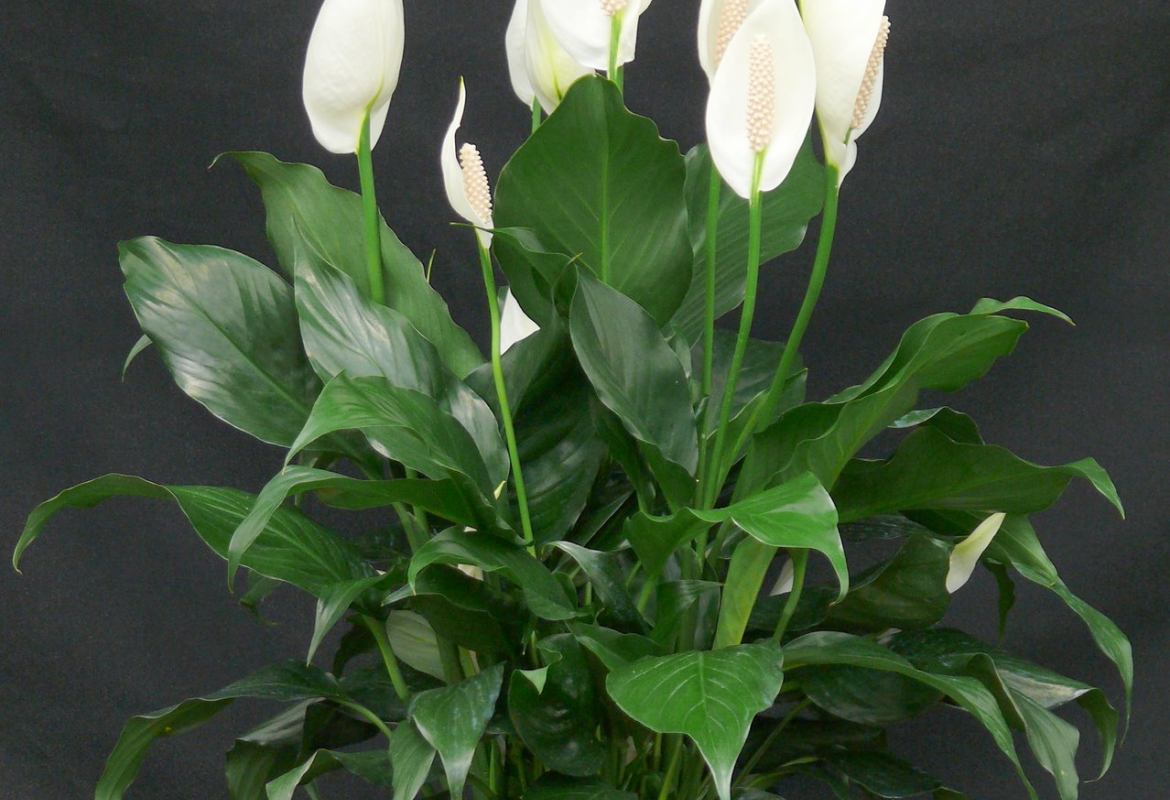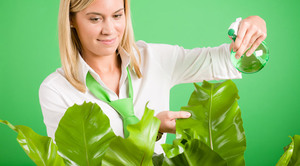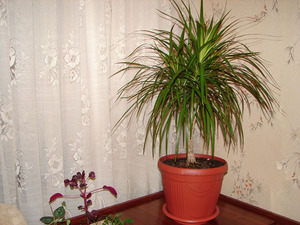Among the many varieties of domestic plants, spathiphyllum is very popular. Many housewives love this tropical flower. Caring for it is simple, but when the cold season comes, the plant reacts sharply to dry air in the living room. The tips of the leaves begin to dry out and turn black. For what reason is an indoor flower sick and how to help a beloved plant?
Description of the plant
Many flower growers know Spatsifilus under another common name - "woman's happiness"... An elegant-looking flower is considered unpretentious to care for and is very popular. It can be seen in almost every home. With proper care, it pleases with its original and exquisite flowering.
The indoor flower belongs to the genus Spathiphyllum and there are 45 plant species in total. Some of these species are very decorative in appearance. The native land of the tropical plant is South America, the tropics of several countries:
- Brazil;
- Colombia;
- Venezuela;
- Philippine Islands.
Unusual inflorescences of a white plant resemble a white blanket. Translated from Greek, the name of the flower has two words - "veil" and "white".
Foliage with solid edges is oval in shape, and in the very center the central vein stands out... Thinner veins adjoin it. The petioles of the flower expand at the base. Species with white inflorescences are mostly common, although there are less rare species with a greenish veil.
Duration of flowering spathiphyllum is about 2-3 weeks in the spring season. If you take care of it correctly, then the flower will delight with its flowering in summer and autumn. When the flowering period has come to an end and the inflorescences have dried up, they must be removed.
Care features
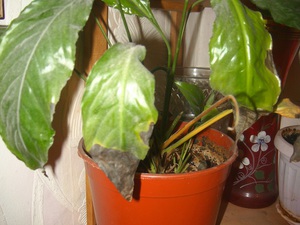 Even such an easy-to-care indoor plant needs constant care and attention. When the leaves of spathiphyllum turn black or begin to turn yellow, dry the tips of the leaves, such symptoms should be an alarming signal. The plant reacts in this way to improper care, disease. It is necessary immediately after the manifestation of the listed signs take action, otherwise the plant will continue to hurt and may soon die.
Even such an easy-to-care indoor plant needs constant care and attention. When the leaves of spathiphyllum turn black or begin to turn yellow, dry the tips of the leaves, such symptoms should be an alarming signal. The plant reacts in this way to improper care, disease. It is necessary immediately after the manifestation of the listed signs take action, otherwise the plant will continue to hurt and may soon die.
Spathiphyllum is one of those plants that need warmth, because it comes from the tropics. It is recommended to create increased indoor humidity for the flower in the warm season. In winter, spathiphyllum should be limited to watering, it does not tolerate excessive moisture well. Excess water from the sump must be removed if it is there.
Indoor flower does not tolerate direct sunlight. For normal development, partial shade is more suitable for him. The temperature regime in the summer should be within 22-23aboutC, and in the cold season the temperature should not fall below 18aboutFROM... The flower reacts very painfully to drafts in the room. If you do not know these features, spathiphyllum will be difficult to grow without problems.
Why do the leaves of the spathiphyllum turn black?
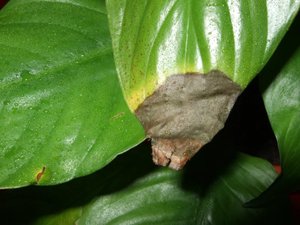 There can be several reasons why problems arise with this plant. Most often, flower growers notice that the tips of the leaves begin to turn black in the flower. This is influenced by various unfavorable conditions for the cultivation of "female happiness".The main indicator of the health and proper care of spathiphyllum is its beautiful appearance. Often, flower growers notice that the tips of the leaves dry out in spathiphyllum. Most likely, such signs are associated with a violation of watering a houseplant.
There can be several reasons why problems arise with this plant. Most often, flower growers notice that the tips of the leaves begin to turn black in the flower. This is influenced by various unfavorable conditions for the cultivation of "female happiness".The main indicator of the health and proper care of spathiphyllum is its beautiful appearance. Often, flower growers notice that the tips of the leaves dry out in spathiphyllum. Most likely, such signs are associated with a violation of watering a houseplant.
Experienced florists distinguish two reasons why the tips of the leaves of the plant turn black:
- excessive watering;
- insufficient feeding.
When a plant is watered too often and is kept in a cool place, its roots begin to rot. Gradually, this is reflected on the leaves of the spathiphyllum - the tips of the leaves dry out, black spots appear on them. When it is seen that the root system begins to darken, then this is a clear sign of damage to gray rot. It is necessary to immediately treat the soil with fungicides, and place the plant in a ventilated room with a temperature of at least 16aboutC. In the winter season, it is better to put the plant on a windowsill facing the south. The plant should be watered only with settled water and the amount of watering should be reduced.
The second reason - lack of feeding... This may be due to insufficient nitrogen or phosphorus in the potting mix. If this is the reason, then you need to apply fertilizer, which includes:
- phosphorus;
- potassium;
- nitrogen.
The dosage of the top dressing should correspond to that indicated on the package. In the warm season, fertilizer is applied once every 2-3 weeks. In the cold season, spathiphyllum does not need fertilization, since it is at rest.
Why do spathiphyllum leaves turn yellow?
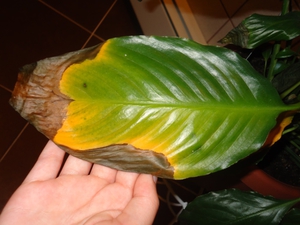 Although spathiphyllum is considered an easy-to-care indoor plant, troubles can appear during its development. Very often you have to observe that the indoor flower turns yellow or dries up and the question immediately arises, why is this happening? Experts believe that the reason is low room humidity... When the air is too dry, the tips of the flower leaves begin to turn yellow or dry at the ends.
Although spathiphyllum is considered an easy-to-care indoor plant, troubles can appear during its development. Very often you have to observe that the indoor flower turns yellow or dries up and the question immediately arises, why is this happening? Experts believe that the reason is low room humidity... When the air is too dry, the tips of the flower leaves begin to turn yellow or dry at the ends.
You can spray the plant more often at home, but this does not always give positive results. Air humidity can be increased in other ways:
- the pot should be placed in a tray with moistened pebbles;
- cover the soil in the pot with moist moss;
- put a container of water next to the pot.
Yellowed or drying leaves may be due to too dry soil or over-watering. The second reason is that the capacity is too small, the flower needs a looser pot.
The main cause of dry and yellow leaves can be direct sunlight or excess sunlight. For instance, direct sunlight will cause burns on the leaves of the plant.
Over-watering the plant can also cause dryness and yellowness of the deciduous mass. It is advisable to water as the topsoil dries up. It is best to spray the leaves of "women's happiness" more often, to avoid stagnant water, to do moderate watering so that the soil is slightly dry, but not dry.
By observing the simple rules for caring for spathiphyllum at home, you can achieve regular flowering. A healthy plant will delight the eye with a luscious green deciduous mass, exquisite white flowers.
